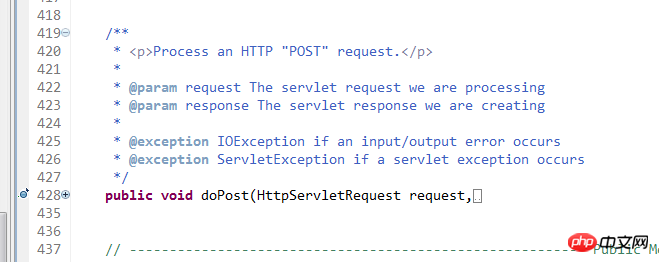이 글에서는 주로 Power Node Java Academy에서 정리한 Struts1 관련 정보의 URL 차단을 소개합니다. 도움이 필요한 친구는
Struts1의 URL 차단
을 참조하세요. 먼저 ActionServlet에 대한 심층적인 분석을 진행해 보겠습니다. 우리는 기본 소스 코드를 살펴보기 위해 중단점 디버깅을 사용합니다. 이 인스턴스는 포스트 모드로 제출되므로 doPost 메소드에 중단점을 설정하십시오.

실행 중인 프로그램을 디버그하고 doPost에 메소드를 입력합니다.

이 메소드는 매우 중요하며 ActionServlet 실행의 핵심 메소드입니다.
이 메소드를 입력합니다:

그런 다음 계속 입력합니다:

우리는 갑자기 이러한 메소드가 문자열을 가로채는 메소드인 processPath 메소드라는 것을 발견했습니다. 이 메소드의 소스 코드는 다음과 같습니다.
/**
* <p>Identify and return the path component(from the request URI) that
* we will use to select an <code>ActionMapping</code> with which todispatch.
* If no such path can be identified,create an error response and return
* <code>null</code>.</p>
*
* @param request The servlet request weare processing
* @param response The servlet response weare creating
*
* @exception IOException if an input/outputerror occurs
*/
protectedString processPath(HttpServletRequest request,
HttpServletResponse response)
throws IOException {
String path = null;
// For prefix matching, match on the path info (if any)
path = (String) request.getAttribute(INCLUDE_PATH_INFO);
if (path == null) {
path = request.getPathInfo();
}
if ((path != null) && (path.length() > 0)) {
return (path);
}
// For extension matching, strip the module prefix and extension
path = (String) request.getAttribute(INCLUDE_SERVLET_PATH);
if (path == null) {
path = request.getServletPath();
}
String prefix = moduleConfig.getPrefix();
if (!path.startsWith(prefix)) {
String msg =getInternal().getMessage("processPath");
log.error(msg + " " + request.getRequestURI());
response.sendError(HttpServletResponse.SC_BAD_REQUEST, msg);
return null;
}
path = path.substring(prefix.length());
int slash = path.lastIndexOf("/");
int period = path.lastIndexOf(".");
if ((period >= 0) && (period >slash)) {
path = path.substring(0, period);
}
return (path);
}이 코드 분석:
path = (String)request.getAttribute(INCLUDE_PATH_INFO);
if (path == null) {
path = request.getPathInfo();
}
if ((path != null) && (path.length() > 0)) {
return (path);
}이 코드는 먼저 javax.servlet.include.path_info에 경로 정보가 있는지 확인합니다. 여기서 페이지가 RequestDispatcher에 표시되는지 알아야 합니다. .include 모드. 이 속성 값이 존재합니다. 따라서 여기에 값이 없으면 path=request.getPathInfo() 프로그램에 들어가게 됩니다. 여기에서 getPathInfo를 통해 얻은 값은 서블릿에 대한 상대 경로 정보입니다.
// For extension matching, stripthe module prefix and extension
path = (String) request.getAttribute(INCLUDE_SERVLET_PATH);
if (path == null) {
path = request.getServletPath();
}
String prefix = moduleConfig.getPrefix();
if (!path.startsWith(prefix)) {
String msg =getInternal().getMessage("processPath");
log.error(msg + " " + request.getRequestURI());
response.sendError(HttpServletResponse.SC_BAD_REQUEST, msg);
return null;
}이 코드는 javax.servlet.include.servlet_path에 값이 있는지 확인하는 코드입니다. 이 속성 값은 페이지가 requestDispatcher.include 모드로 표시될 때만 존재하므로 여기에는 값이 없습니다. 그런 다음 path = request.getServletPath()를 입력합니다. 이 메소드는 요청 URI 컨텍스트를 반환한 후 하위 문자열을 가져오는 것이므로 여기서 반환 값은 "/"이고 액세스 페이지 이름과 접미사입니다(이것은 내 mvc 인스턴스에서 가로채는 것과 동일합니다). 원칙). 그런 다음 다음 코드를 입력하세요.
path = path.substring(prefix.length());
intslash = path.lastIndexOf("/");
intperiod = path.lastIndexOf(".");
if((period >= 0) && (period > slash)) {
path = path.substring(0, period);
}
return (path); 여기의 방법은 주로 위의 방법과 동일하며, 가장 중요한 것은 접미사를 제거하는 것입니다.
위 내용은 Struts1 URL 차단에 대한 자세한 소개의 상세 내용입니다. 자세한 내용은 PHP 중국어 웹사이트의 기타 관련 기사를 참조하세요!